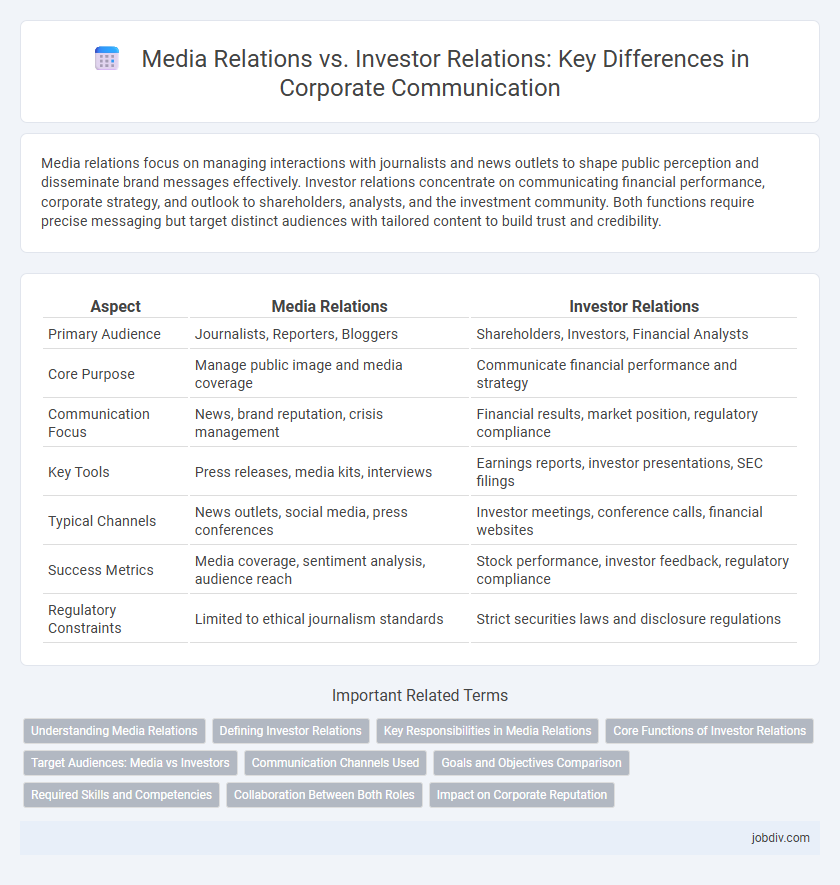Media relations focus on managing interactions with journalists and news outlets to shape public perception and disseminate brand messages effectively. Investor relations concentrate on communicating financial performance, corporate strategy, and outlook to shareholders, analysts, and the investment community. Both functions require precise messaging but target distinct audiences with tailored content to build trust and credibility.
Table of Comparison
| Aspect | Media Relations | Investor Relations |
|---|---|---|
| Primary Audience | Journalists, Reporters, Bloggers | Shareholders, Investors, Financial Analysts |
| Core Purpose | Manage public image and media coverage | Communicate financial performance and strategy |
| Communication Focus | News, brand reputation, crisis management | Financial results, market position, regulatory compliance |
| Key Tools | Press releases, media kits, interviews | Earnings reports, investor presentations, SEC filings |
| Typical Channels | News outlets, social media, press conferences | Investor meetings, conference calls, financial websites |
| Success Metrics | Media coverage, sentiment analysis, audience reach | Stock performance, investor feedback, regulatory compliance |
| Regulatory Constraints | Limited to ethical journalism standards | Strict securities laws and disclosure regulations |
Understanding Media Relations
Media relations involves managing interactions between an organization and journalists to shape public perception and secure positive coverage. This facet of communication emphasizes crafting compelling press releases, responding to media inquiries, and building long-term relationships with reporters and editors. Effective media relations enhances brand visibility, influences public opinion, and supports reputation management through timely and accurate information dissemination.
Defining Investor Relations
Investor Relations (IR) involves managing communication between a company and its investors, ensuring transparent and accurate dissemination of financial information to maintain investor confidence. Unlike Media Relations, which targets journalists and the general public to shape the company's public image, Investor Relations specifically focuses on engaging shareholders, analysts, and regulatory bodies with detailed reports, earnings releases, and strategic updates. Effective IR strategies enhance investor trust, support stock valuation, and comply with regulatory requirements such as those mandated by the Securities and Exchange Commission (SEC).
Key Responsibilities in Media Relations
Media relations primarily involve managing relationships with journalists, crafting press releases, and coordinating media coverage to enhance brand visibility and reputation. Key responsibilities include responding to media inquiries, arranging interviews, and monitoring news outlets to gauge public perception and media impact. These efforts ensure consistent messaging and proactive engagement with the press to build trust and maintain a positive public image.
Core Functions of Investor Relations
Investor Relations centers on managing communication between a company's management and its existing and potential investors, providing critical financial data, quarterly earnings reports, and strategic corporate updates to maintain investor confidence. Core functions include coordinating shareholder meetings, ensuring compliance with financial regulations, and facilitating transparent disclosure of financial performance and outlook to attract and retain long-term investors. Unlike Media Relations, which targets broader public and media outlets, Investor Relations prioritizes accuracy, regulatory adherence, and tailored financial messaging to support stock valuation and capital access.
Target Audiences: Media vs Investors
Media relations focus on engaging journalists, editors, and influencers to shape public perception and generate coverage that reaches a broad audience. Investor relations target shareholders, analysts, and potential investors to provide detailed financial information, ensuring transparency and fostering confidence in the company's fiscal health. Understanding the distinct priorities and communication styles of these audiences is crucial for tailoring messages that effectively support corporate objectives.
Communication Channels Used
Media relations primarily utilizes press releases, news conferences, and social media platforms to engage journalists and influence public perception. Investor relations relies on earnings calls, annual reports, investor meetings, and regulatory filings to communicate financial performance and corporate strategy. Both channels employ digital platforms but target distinct audiences with tailored messaging to optimize stakeholder engagement.
Goals and Objectives Comparison
Media relations primarily focus on managing communication between an organization and the press to enhance brand image, increase public awareness, and shape public perception. Investor relations concentrate on fostering transparency and trust with shareholders and potential investors by providing accurate financial information and addressing concerns related to company performance and growth. Both functions aim to build credibility but target different audiences with tailored messaging to achieve strategic organizational goals.
Required Skills and Competencies
Media relations demands strong storytelling abilities, exceptional verbal communication, and crisis management skills to effectively engage journalists and the public. Investor relations requires deep financial acumen, analytical skills, and proficiency in regulatory compliance to build trust with shareholders and analysts. Both fields rely on strategic messaging, relationship management, and the ability to translate complex information into clear, persuasive communications.
Collaboration Between Both Roles
Media relations and investor relations teams collaborate closely to ensure consistent messaging across public and financial communications, enhancing corporate transparency and reputation management. Effective collaboration involves synchronized press releases, coordinated crisis communication strategies, and unified stakeholder engagement to maintain trust among investors, journalists, and the public. Integrating data-driven insights from both teams optimizes communication impact, strengthens brand credibility, and supports strategic business objectives.
Impact on Corporate Reputation
Media relations shape corporate reputation by managing public perception through strategic storytelling and timely response to news cycles, influencing brand trust and credibility. Investor relations impact reputation by ensuring transparency and consistent financial communication, which strengthens investor confidence and supports market valuation. Both functions are critical, with media relations driving broad public awareness and investor relations fostering financial stakeholder trust.
Media Relations vs Investor Relations Infographic

 jobdiv.com
jobdiv.com